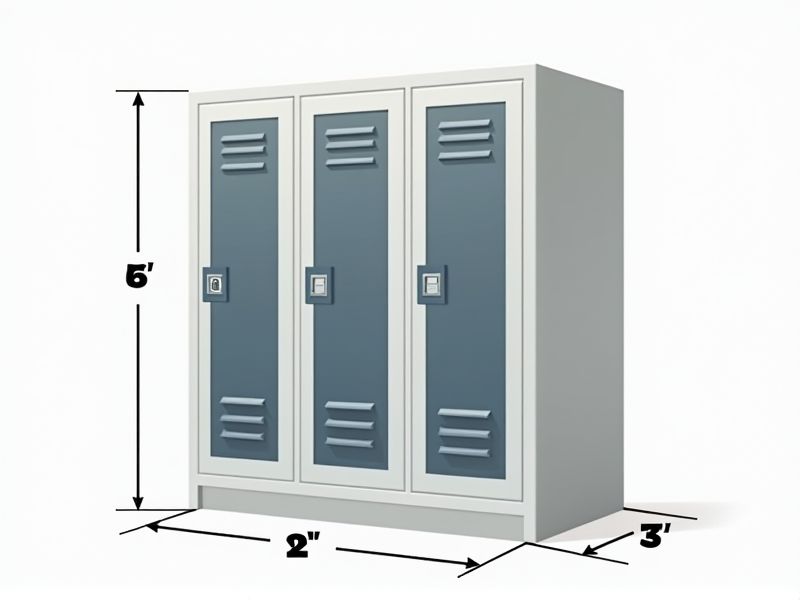
Standard gym lockers are typically designed for both functionality and space optimization. Commonly, a single-tier locker measures about 12 inches wide, 18 inches deep, and 72 inches high, offering ample room for clothing, shoes, and gym bags. Some gyms also use half-height (double-tier) lockers, which are usually 12-15 inches wide, 15-18 inches deep, and around 36 inches high per compartment, to maximize the number of lockers in a smaller area. Always check with your facility, as specific dimensions may vary based on manufacturer or local requirements.
Height
The standard height of gym lockers typically ranges between 60 to 72 inches, accommodating the needs of various users. These lockers are designed to provide ample vertical space for hanging garments and storing personal items securely. Most facilities ensure a width of around 12 to 18 inches, allowing enough room for your belongings without compromising the overall locker room layout. When selecting a gym, consider the height and dimensions of the lockers to ensure they meet your storage requirements effectively.
Width
Gym lockers typically have standard widths ranging from 12 to 18 inches, with the most common being around 15 inches. This width is designed to accommodate personal items like gym bags, shoes, and clothes efficiently without taking up excessive space. Depending on the facility, some lockers may be wider, reaching up to 24 inches for additional storage needs. When selecting a gym locker, consider not only its width but also its depth and height to ensure it meets your storage requirements effectively.
Depth
Locker depth in gym facilities typically ranges from 18 to 24 inches, providing ample space for personal belongings. A well-designed locker ensures easy storage of gym bags, shoes, and clothing, while maximizing the available area without compromising accessibility. For optimal functionality, lockers should be constructed from durable materials that can withstand frequent use and maintain a clean appearance. When choosing a locker, consider your specific storage needs, as deeper lockers offer extra room for larger items like workout equipment or sports gear.
Ventilation
Proper ventilation in gym lockers is crucial for maintaining a fresh and hygienic environment. Studies reveal that gyms with optimal air circulation can reduce humidity levels by up to 50%, minimizing the growth of mold and mildew. High-quality ventilation systems should exchange indoor air with fresh outdoor air approximately 10 to 12 times per hour, ensuring that odors and airborne bacteria are effectively eliminated. Prioritizing ventilation not only enhances your gym experience but also promotes better health and wellness for all members.
Material
Gym lockers are primarily constructed from durable materials such as stainless steel, laminate, and metal to ensure strength and longevity. Stainless steel lockers offer superior resistance to corrosion and vandalism, making them ideal for high-traffic environments. Laminate lockers provide a variety of design options and are resistant to moisture, which is crucial in gym settings. Metal gym lockers, often treated with powder coating, present an affordable option that balances durability with aesthetics.
Security Features
Modern gym lockers prioritize security features to ensure the safety of personal belongings. Keyless entry systems, such as biometric locks or RFID technology, eliminate the need for physical keys while providing secure access based on unique fingerprints or cards. Many lockers are constructed with anti-theft materials, making them resistant to tampering and break-ins. In addition, surveillance cameras are often installed in locker areas to deter theft and provide added peace of mind for your valuables.
Weight Capacity
When selecting a gym locker, consider that standard weight capacities typically range from 100 to 250 pounds. This ensures that your personal items, including heavy bags or equipment, are securely stored while maintaining the locker's structural integrity. High-quality lockers may even support additional weight, accommodating specific needs for athletic gear or equipment. Always check the manufacturer's specifications to ensure that the locker meets your weight requirements and offers reliable storage solutions.
Number Of Compartments
A standard gym locker typically features around 36 compartments, designed to accommodate the diverse needs of gym-goers. Each compartment generally measures about 12 inches wide, 18 inches deep, and 72 inches high, providing ample storage space for personal items. Many facilities offer options for both individual and shared lockers, enhancing convenience while maximizing available space. Investing in a locker system with adequate compartments ensures that your belongings remain secure and accessible during workouts.
Color Options
When choosing a gym locker, color options play a crucial role in enhancing both aesthetics and functionality. Popular choices include vibrant shades like red or blue, which can energize the environment, while neutral tones such as gray and white promote a clean, modern look. Many gyms provide customization options, offering over 10 distinct colors to match your branding or personal preference. Selecting a color that resonates with you can improve your overall gym experience, making it a more inviting space to return to regularly.
Installation Type
Gym lockers are typically categorized by their installation type, which can greatly influence their functionality and user experience. Wall-mounted lockers save space and are ideal for smaller facilities, while free-standing lockers offer flexibility in layout and accessibility. Modular locker systems provide customizable configurations, allowing gyms to optimize their spaces for both storage and aesthetic appeal. When choosing a gym locker, consider factors such as material durability, security features, and the number of users, as these elements can impact your overall satisfaction and usage efficiency.
